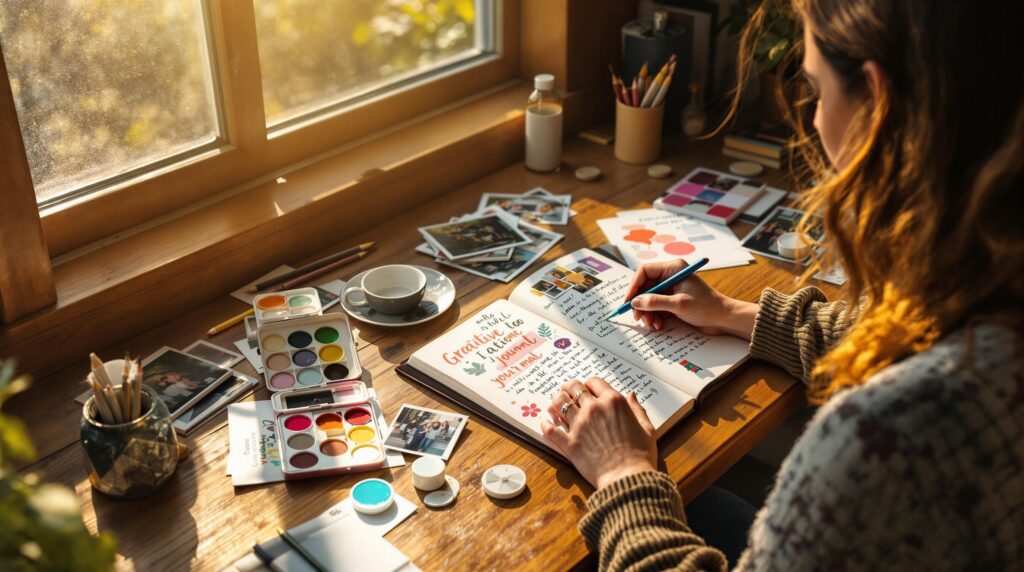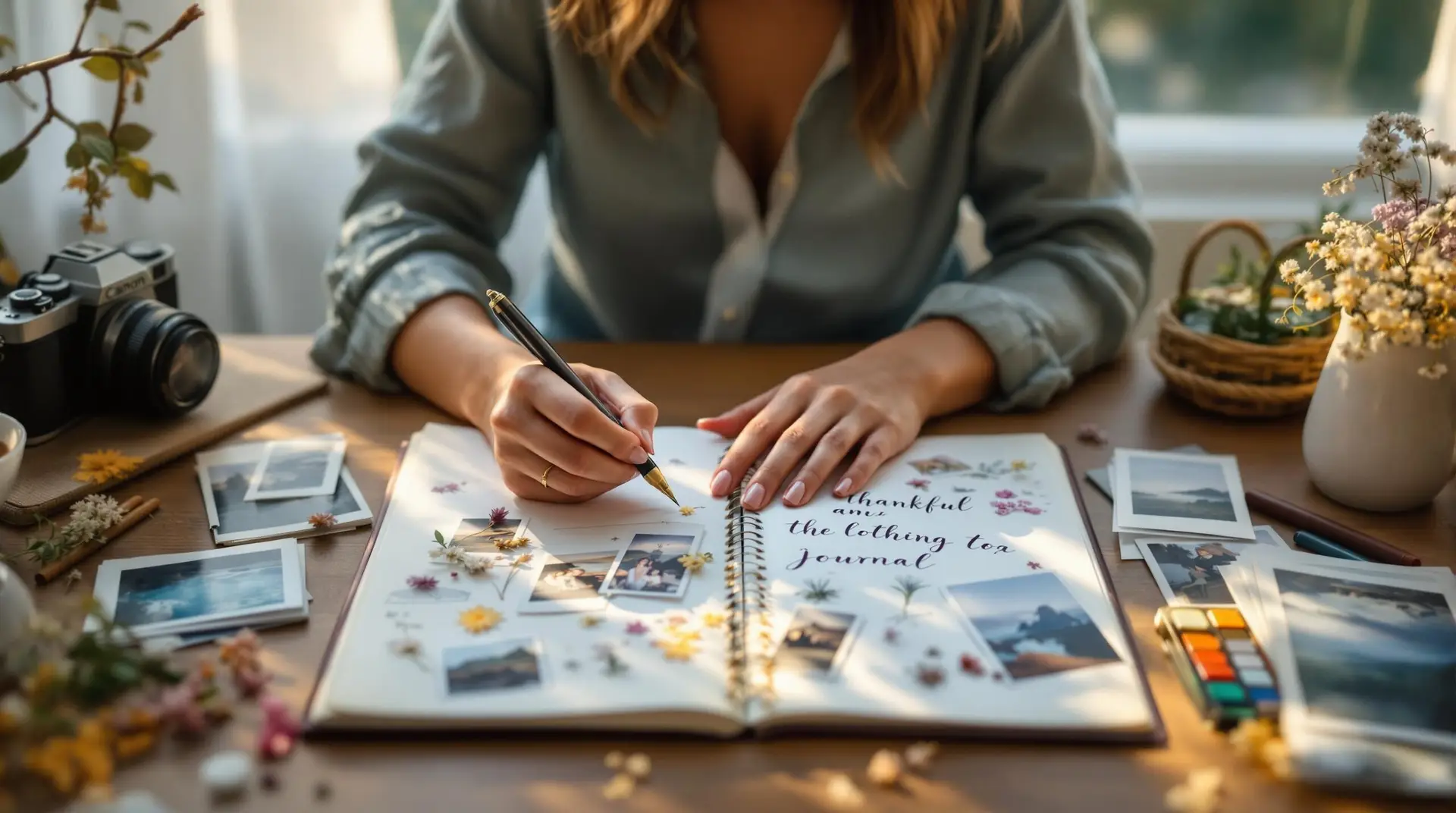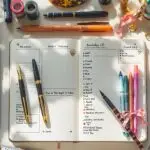Traditional gratitude journaling often falls flat after the initial enthusiasm wears off. Writing the same “I’m grateful for my family” entries becomes routine, losing the emotional impact that makes gratitude practice transformative. Creative gratitude journaling techniques offer a solution by engaging different parts of your brain and creating lasting positive change.
According to a study by Personality and Individual Differences, individuals who practice gratitude journaling techniques beyond simple “thank you” lists show 43% greater improvements in well-being compared to traditional gratitude practices. Creative gratitude journaling methods that incorporate sensory details, storytelling, and artistic elements activate multiple brain regions, creating stronger neural pathways for positive thinking and emotional regulation.
Key Takeaways
- Visual techniques like gratitude mapping and photo collages enhance memory retention and emotional impact
- Sensory-based prompts create deeper connections to grateful experiences than simple listing methods
- Story-driven approaches transform routine gratitude practice into meaningful personal narratives
- Creative formats including letters, poetry, and artwork prevent gratitude fatigue and maintain long-term engagement
- Structured challenges provide accountability and progression that traditional journaling often lacks
The Science Behind Creative Gratitude Journaling
Research from Current Directions in Psychological Science reveals that creative gratitude journaling activates the brain’s reward system more effectively than traditional methods. When you incorporate artistic elements, storytelling, or sensory details, you engage multiple neural networks simultaneously.
Dr. Robert Emmons, a leading gratitude researcher at UC Davis, found that creative approaches to gratitude practice increase the production of dopamine and serotonin by up to 25%. This neurochemical boost creates a positive feedback loop that makes gratitude journaling more enjoyable and sustainable.
The key difference lies in specificity and engagement. Standard gratitude lists often become routine and lose their emotional impact. Creative techniques force you to think differently about your experiences, creating new neural pathways that strengthen your natural tendency toward gratitude.
This research-backed approach to gratitude journaling goes beyond simple list-making to create lasting behavioral change. Watch this video to see creative gratitude journaling techniques in action:
Visual Gratitude Journaling Techniques
Gratitude Mapping for Enhanced Memory
Create visual maps that connect grateful moments to specific locations, people, or experiences. Start with a central circle containing your main gratitude theme for the day. Branch out with colored lines connecting related experiences, emotions, and sensory details.
This technique works because spatial memory is one of the strongest forms of human memory. When you visualize your grateful experiences in relation to physical spaces or conceptual maps, you create multiple retrieval cues that make these positive memories more accessible.
Photo Collage Gratitude Journaling
Combine photographs with written reflections to create visual narratives. Take photos of moments, objects, or people you’re grateful for, then write brief stories about why each image matters to you.
Research from Psychological Science shows that visual-verbal combinations create stronger emotional memories than either format alone. Your brain processes images 60,000 times faster than text, making photo-based gratitude journaling particularly effective for quick emotional shifts.
Sensory-Based Gratitude Journaling
The Five Senses Approach
Transform simple gratitude observations into rich sensory experiences. Instead of writing “I’m grateful for my morning coffee,” expand to include all five senses: the rich aroma, the warmth of the mug in your hands, the sound of brewing, the taste of the first sip, and the visual steam rising from the cup.
This approach activates your sensory cortex, creating more vivid and lasting memories. Studies show that sensory-rich memories are recalled with 65% greater accuracy than basic factual memories.
Gratitude Through Touch and Texture
Incorporate physical objects into your gratitude journaling practice. Write about the texture of a loved one’s hand, the smoothness of a favorite stone, or the softness of a pet’s fur. These tactile memories create strong emotional anchors that enhance your gratitude practice.
Physical textures trigger powerful emotional responses because touch is processed in the same brain regions as emotional memories. This connection makes tactile gratitude journaling particularly effective for people who struggle with traditional writing-based approaches.
Story-Driven Gratitude Journaling Methods
The Gratitude Letter Technique
Write detailed letters to people you’re grateful for, focusing on specific actions and their impact on your life. Research by Martin Seligman at the University of Pennsylvania found that gratitude letters create lasting improvements in happiness that persist for up to three months.
The power lies in specificity and narrative structure. Instead of general appreciation, tell the story of how someone’s actions affected you. Describe the context, the action, and the lasting impact on your life.
Gratitude Storytelling for Personal Growth
Transform daily grateful moments into complete narratives with beginning, middle, and end. This technique helps you recognize patterns in your life and identify sources of consistent joy and meaning.
Professional storytellers report that narrative-based gratitude practice helps them identify recurring themes in their lives, leading to greater self-awareness and intentional living. The process of crafting stories forces you to examine the deeper meaning behind grateful moments.
Creative Format Experiments in Gratitude Journaling
Poetry and Haiku for Gratitude Expression
Express gratitude through poetry, particularly haiku, which forces you to distill experiences into their essence. The 5-7-5 syllable structure creates creative constraints that often lead to surprising insights and deeper emotional connections.
Poetry engages the brain’s creative centers while processing emotional content. This dual engagement creates stronger neural connections between creativity and gratitude, making both practices more rewarding and sustainable.
Artistic Gratitude Journaling
Incorporate drawing, painting, or other artistic mediums into your gratitude practice. Even simple sketches or color associations can enhance the emotional impact of your gratitude journaling.
Art therapy research shows that creative expression activates the brain’s reward system independently of artistic skill level. The act of creating something visual to accompany your grateful thoughts strengthens the positive emotional associations with those experiences.
Advanced Gratitude Journaling Techniques
The Gratitude Time Travel Method
Write gratitude entries from the perspective of your future self, looking back on current experiences. This technique helps you recognize the potential long-term value of present moments and creates a sense of anticipation for positive outcomes.
Temporal perspective research indicates that viewing current experiences through the lens of future memory creates stronger emotional connections and increased appreciation for present circumstances.
Gratitude Journaling Through Character Development
Create fictional characters who experience situations similar to your own, then write about what these characters might be grateful for. This technique provides emotional distance that can reveal insights about your own life while maintaining the benefits of gratitude practice.
Narrative therapy techniques show that creating distance through character development allows for more honest self-reflection and reduced emotional reactivity to difficult situations.
Implementing Creative Gratitude Journaling Systems
The Weekly Gratitude Theme Approach
Assign different creative techniques to different days of the week. Monday might be visual mapping, Tuesday could be sensory writing, Wednesday might focus on gratitude letters, and so on. This systematic approach prevents boredom and ensures you experience the full range of creative gratitude techniques.
Structure provides the framework for creativity to flourish. When you know what type of creative gratitude journaling you’ll do each day, you can prepare mentally and gather any necessary materials in advance.
Seasonal Gratitude Journaling Adaptations
Adapt your creative gratitude journaling techniques to match seasonal themes and activities. Summer might emphasize outdoor sensory experiences, while winter could focus on indoor comfort and reflection. This approach keeps your practice fresh and connected to your natural environment.
For those interested in exploring more structured approaches, consider trying our 30-day challenge that incorporates many of these creative techniques into a progressive system.
Building Long-Term Creative Gratitude Habits
Overcoming Creative Gratitude Blocks
Even creative gratitude journaling can become routine if you don’t actively vary your approaches. When you notice your practice becoming automatic, intentionally choose the technique that feels most challenging or unfamiliar.
The key to sustaining creative gratitude journaling lies in embracing discomfort with new approaches. Growth occurs when you push beyond your comfort zone, and this principle applies to gratitude practice as much as any other skill.
Measuring the Impact of Creative Gratitude Journaling
Track the emotional impact of different creative techniques by rating your mood before and after each session. This data helps you identify which approaches work best for your personality and circumstances.
Consider keeping a simple scale rating system alongside your creative gratitude journaling. Rate your mood from 1-10 before and after each session, and note which techniques produce the greatest positive shifts.
The research on the science behind gratitude journaling supports the effectiveness of tracking your emotional responses to different techniques, as this awareness itself becomes part of the positive feedback loop.
Troubleshooting Common Creative Gratitude Challenges
When Creative Gratitude Journaling Feels Forced
If creative techniques feel artificial or forced, start with micro-experiments. Spend just two minutes adding one sensory detail to a basic gratitude entry, or draw a simple doodle next to your written gratitude note.
The goal isn’t to create masterpiece art or profound literature. The goal is to engage different parts of your brain in the gratitude process. Even small creative additions can significantly enhance the emotional impact of your practice.
Adapting Techniques for Different Personalities
Introverts might prefer writing detailed gratitude letters they never send, while extroverts might enjoy creating gratitude presentations or videos. Visual learners benefit from mapping and photo techniques, while kinesthetic learners might prefer tactile approaches.
The most effective creative gratitude journaling technique is the one you’ll actually use consistently. Experiment with different approaches until you find methods that feel natural and energizing rather than burdensome.
For additional inspiration and structured approaches, explore our comprehensive gratitude journal prompts guide that includes many creative variations on traditional gratitude exercises.
Start Your Creative Gratitude Journey Today
Creative gratitude journaling transforms a simple practice into a rich, multifaceted experience that engages your whole brain. By incorporating visual, sensory, and narrative elements, you create lasting positive changes in your neural pathways and emotional well-being.
Begin with just one technique that appeals to you. Whether it’s adding a simple sketch to your gratitude entry or writing a brief story about a grateful moment, small creative additions can produce significant improvements in your emotional state and overall life satisfaction.
Remember that consistency matters more than perfection. Choose techniques that feel natural and enjoyable, and gradually expand your creative gratitude journaling practice as you build confidence and see results.
FAQ
How long should I spend on creative gratitude journaling each day?
Start with 5-10 minutes daily using one creative technique. Quality matters more than quantity. Consistent brief sessions create stronger habits than occasional lengthy ones.
Can I combine multiple creative techniques in one session?
Yes, but avoid overwhelming yourself. Try combining two complementary techniques like sensory writing with simple sketching, or photo collages with brief stories.
What if I’m not artistic or creative?
Artistic skill isn’t required. Simple doodles, basic photos, or short poems work just as well. The brain benefits come from the creative process, not the artistic outcome.
How do I know if creative gratitude journaling is working?
Track your mood before and after sessions, notice if you feel more optimistic throughout the day, and observe whether you naturally notice more positive aspects of your experiences.
Should I share my creative gratitude journal with others?
This depends on your comfort level. Some techniques like gratitude letters are meant to be shared, while others work better as private reflection. Choose what feels authentic to you.
Sources:
University of California Berkeley
Harvard Medical School
Journal of Marriage and Family





